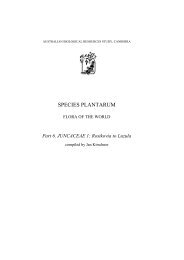Amborellaceae - Species Plantarum Programme
Amborellaceae - Species Plantarum Programme
Amborellaceae - Species Plantarum Programme
Create successful ePaper yourself
Turn your PDF publications into a flip-book with our unique Google optimized e-Paper software.
SPECIES PLANTARUM – FLORA OF THE WORLD 2008<br />
L.L.Money, I.W.Bailey & B.G.L.Swamy, The morphology and relationships of the Monimiaceae,<br />
J. Arnold Arbor. 31: 372-404 (1950); J.Jérémie, <strong>Amborellaceae</strong>, in Fl. Nouvelle-<br />
Calédonie & Dépend. 11: 157-160 (1982); F.B.Sampson, Pollen morphology of the <strong>Amborellaceae</strong><br />
and Hortoniaceae (Hortonioideae: Monimiaceae), Grana 32: 154-162 (1993); M.W.Chase<br />
et al., Phylogenetics of seed plants: an analysis of nucleotide sequences from the plastid gene<br />
rbcL, Ann. Missouri Bot. Gard. 80: 526-580 (1993); S.Mathews & M.J.Donoghue, The root of<br />
angiosperm phylogeny inferred from duplicate phytochrome genes, Science 286: 947-950 (1999);<br />
Y.-L.Qui, J.Lee, F.Bernasconi-Quadroni, D.E.Soltis, P.S.Soltis, M.Zanis, E.A.Zimmer, Z.Chen,<br />
V.Savolainen & M.W.Chase, The earliest angiosperms: Evidence from mitochondrial, plastid,<br />
and nuclear genomes, Nature 402: 404-407 (1999); C.L.Parkinson, K.L.Adams & J.D.Palmer,<br />
Multigene analyses identify the three earliest lineages of extant flowering plants, Current Biol.<br />
9: 1485-1488 (1999); P.K.Endress & A.Igersheim, The reproductive structures of the basal<br />
angiosperm Amborella trichopoda (<strong>Amborellaceae</strong>), Int. J. Pl. Sci. 161: suppl., pp. 237-248<br />
(2000); T.S.Feild, M.A.Zweiniecki, T.Brodribb, T.Jaffré, M.J.Donoghue & N.M.Holbrook,<br />
Structure and function of tracheary elements in Amborella trichopoda, Int. J. Pl. Sci. 161: 705-<br />
712 (2000); H.Tobe, T.Jaffré & P.H.Raven, Embryology of Amborella (<strong>Amborellaceae</strong>): descriptions<br />
and polarity of character states, J. Pl. Res. 113: 271-280 (2000); K.Oginuma, T.Jaffré &<br />
H.Tobe, The karyotype analysis of somatic chromosomes in Amborella trichopoda (<strong>Amborellaceae</strong>),<br />
J. Pl. Res. 113: 281-283 (2000); T.Yamada, H.Tobe, R.Imaichi & M.Kato, Developmental<br />
morphology of the ovules of Amborella trichopoda (<strong>Amborellaceae</strong>) and Chloranthus<br />
serratus (Chloranthaceae), Bot. J. Linn. Soc. 137: 277-290 (2001); M.Hesse, Pollen characters<br />
of Amborella trichopoda (<strong>Amborellaceae</strong>): a reinvestigation, Int. J. Pl. Sci. 162: 201-208 (2001);<br />
S.L.Carlquist & E.L.Schneider, Vegetative anatomy of the New Caledonian endemic Amborella<br />
trichopoda: relationships with the Illiciales and implications for vessel origin, Pac. Sci. 55: 305-<br />
312 (2001); S.K.Floyd & W.E.Friedman, Developmental evolution of endosperm in basal<br />
angiosperms: evidence from Amborella (<strong>Amborellaceae</strong>), Nuphar (Nymphaeaceae), and Illicium<br />
(Illiaceae), Pl. Syst. Evol. 228: 153-169 (2001); I.J.Leitch & L.Hanson, DNA C-values<br />
in seven families fill phylogenetic gaps in the basal angiosperms, Bot. J. Linn. Soc. 140: 175-<br />
179 (2002); U.Posluszny & P.B.Tomlinson, Aspects of inflorescence and floral development in<br />
the putative basal angiosperm Amborella trichopoda (<strong>Amborellaceae</strong>), Canad. J. Bot. 81: 28-<br />
39 (2003); V.V.Goremykin, K.I.Hirsch-Ernst, S.Wolfl, F.H.Hellwig, Analysis of the Amborella<br />
trichopoda chloroplast genome sequence suggests that Amborella is not a basal angiosperm,<br />
Molec. Biol. Evol. 20: 1499-1505 (2003); APG II [M.W.Chase et al.], An update of the<br />
Angiosperm Phylogeny Group classification for the orders and families of flowering plants:<br />
APG II, Bot. J. Linn. Soc. 141: 399-436 (2003); L.B.Thien, T.L.Sage, T.Jaffré, P.Bernhardt,<br />
V.Pontieri, P.H.Weston, D.Malloch, H.Azuma, S.W.Graham, M.A.McPherson, H.S.Rai, R.F.Sage<br />
& J.-L.Dupré, The population structure and floral biology of Amborella trichopoda (<strong>Amborellaceae</strong>),<br />
Ann. Missouri Bot. Gard. 90: 466-490 (2003); G.V.Degtjareva, T.H.Samigullin,<br />
D.D.Sokoloff & C.M.Valiejo-Roman, Gene sampling versus taxon sampling: is Amborella<br />
(<strong>Amborellaceae</strong>) a sister group to all other extant angiosperms?, Bot. Zhurn. 89: 896-907 (2004);<br />
D.E.Soltis & P.S.Soltis, Amborella not a “basal angiosperm”? Not so fast, Amer. J. Bot. 91: 997-<br />
1001 (2004); U.Bergthorsson, A.O.Richardson, G.J.Young, L.R.Goertzen & J.D.Palmer,<br />
Massive horizontal transfer of mitochondrial genes from diverse land plant donors to the basal<br />
angiosperm Amborella, Proc. Natl. Acad. Sci. U.S.A. 101: 17747-17752 (2004); S.Aoki,<br />
K.Uehara, M.Imafuku, M.Hasebe & M.Ito, Phylogeny and divergence of basal angiosperms<br />
inferred from APETALA3- and PISTILLATA-like MADS-box genes, J. Pl. Res. 117: 229-244<br />
(2004); M.Buzgo, P.S.Soltis & D.E.Soltis, Floral developmental morphology of Amborella trichopoda<br />
(<strong>Amborellaceae</strong>), Int. J. Pl. Sci. 165: 925-947 (2004); A.V.F.C.Bobrov, P.K.Endress,<br />
A.P.Melikian, M.S.Romanov, A.N.Sorokin & A.P.Bejerano, Fruit structure of Amborella trichopoda<br />
(<strong>Amborellaceae</strong>), Bot. J. Linn. Soc. 148: 265-274 (2005); P.J.Lockhart & D.Penny, The<br />
place of Amborella within the radiation of angiosperms, Trends Pl. Sci. 10: 201-202 (2005).<br />
2












